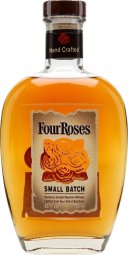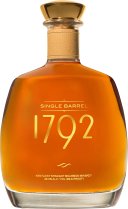Four Roses Small Batch Bourbon Whiskey
The Four Roses distillery is located in Lawrenceburg, Kentucky on the banks of the Salt River in Anderson County. The distillery has a unique Spanish Mission-style architecture rarely seen in Kentucky and is listed on the National Register of Historic Places. The company attributes their products quality to several factors: A unique Limestone water source, the spring-fed Salt River; a high quality grain source (Four Roses are the only distillery using the same grain source for 45 years, paying a premium for quality); Two Mash Bills in daily production - one mash bill contains significantly more rye than any other Bourbon, resulting in a spicy, full-bodied taste; and five proprietary yeast strains, each producing uniquely different flavours. Tasting note: Polished brass gold. Aromas of lamington cake and cherry ripe interchange with peppermint and drying oak as damp cedar wood enters. Lots of American oak input in the mouth: anise infused honey, cocoa and cherry ripe. A splash of minty-rye to finish. Rounds off finely tannic/peppery with hints of Turkish Delight and caramel fudge in the aftertaste. Youthful, but surprises with its complexity. Solid value if you're looking for a rye-heavy Bourbon. 45% Alc./Vol.
1792 Single Barrel Kentucky Straight Bourbon Whiskey
Barton 1792 Distillery was established in 1879 and continues today as the oldest fully-operating Distillery in Bardstown, Kentucky. Situated in heart of bourbon country on 196 acres, the Distillery boasts 29 barrel aging warehouses, 22 other buildings including an impressive still house, and the legendary Tom Moore Spring. In order to create this unique bourbon, the finest barrels are selected and tasted from the best aging warehouses. Only those barrels deemed "exceptional" are then bottled individually, one by one. This preserves the distinct character of each barrel. This superior bourbon has flavors of rich butterscotch and caramel notes, delicately balanced with hints of fruit and toffee.

